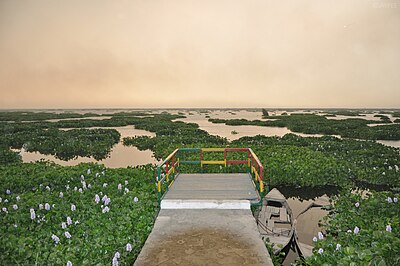
Search
Ramsar site

A Ramsar site is a wetland site designated to be of international importance under the Ramsar Convention, also known as "The Convention on Wetlands", an international environmental treaty signed on 2 February 1971 in Ramsar, Iran, under the auspices of UNESCO. It came into force on 21 December 1975, when it was ratified by a sufficient number of nations. It provides for national action and international cooperation regarding the conservation of wetlands, and wise sustainable use of their resources. Ramsar identifies wetlands of international importance, especially those providing waterfowl habitat.
As of November 2023, there are 2,500 Ramsar sites around the world, protecting 257,106,360 hectares (635,323,700 acres), and 172 national governments are participating.
Site listings
The non-profit organisation Wetlands International provides access to the Ramsar database via the Ramsar Sites Information Service.
Ramsar site criteria
A wetland can be considered internationally important if any of the following nine criteria apply:
- Criterion 1: "it contains a representative, rare, or unique example of a natural or near-natural wetland type found within the appropriate biogeographic region."
- Criterion 2: "it supports vulnerable, endangered, or critically endangered species or threatened ecological communities."
- Criterion 3: "it supports populations of plant and/or animal species important for maintaining the biological diversity of a particular biogeographic region."
- Criterion 4: "it supports plant and/or animal species at a critical stage in their life cycles, or provides refuge during adverse conditions."
- Criterion 5: "it regularly supports 20,000 or more waterbirds."
- Criterion 6: "it regularly supports 1% of the individuals in a population of one species or subspecies of waterbird."
- Criterion 7: "it supports a significant proportion of indigenous fish subspecies, species or families, life-history stages, species interactions and/or populations that are representative of wetland benefits and/or values and thereby contributes to global biological diversity."
- Criterion 8: "it is an important source of food for fishes, spawning ground, nursery and/or migration path on which fish stocks, either within the wetland or elsewhere, depend."
- Criterion 9: "it regularly supports 1% of the individuals in a population of one species or subspecies of wetland-dependent non-avian animal species."
Classification
The Ramsar Classification System for Wetland Type is a wetland classification developed within the Ramsar Convention intended as a means for fast identification of the main types of wetlands for the purposes of the Convention.
Marine/coastal wetlands
- Saline water:
- Permanent:
- (A) Permanent shallow marine waters: Less than 6m deep at low tide; including sea bays and straits
- (B) Marine subtidal aquatic beds: Underwater vegetation; including kelp beds and sea grass beds, and tropical marine meadows
- (C) Coral reefs
- Shores:
- (D) Rocky marine shores
- (E) Sand, shingle or pebble shores
- Permanent:
- Saline or brackish water:
- Intertidal:
- (G) Intertidal mud, sand or salt flats
- (H) Intertidal marshes
- (I) Intertidal forested wetlands
- Lagoons:
- (J) Coastal brackish/saline lagoons
- Estuarine waters:
- (F) Estuarine waters
- Intertidal:
- Saline, brackish, or fresh water:
- Subterranean:
- (Zk(a)) Karst and other Subterranean hydrological systems
- Subterranean:
- Fresh water:
- Lagoons:
- (K) Coastal freshwater lagoons
- Lagoons:
Inland wetlands
- Fresh water:
- Flowing water:
- Permanent:
- Permanent inland river deltas (L)
- Permanent rivers/creeks/streams (M)
- Freshwater springs, oases (Y)
- Seasonal/intermittent rivers/creeks/streams (N)
- Permanent:
- Lakes/pools:
- Permanent >8 ha (O)
- Permanent < 8 ha(Tp)
- Seasonal / Intermittent > 8 ha (P)
- Seasonal Intermittent < 8 ha(Ts)
- Marshes on inorganic soils:
- Permanent (herb dominated) (Tp)
- Permanent / Seasonal / Intermittent (shrub dominated)(W)
- Permanent / Seasonal / Intermittent (tree dominated) (Xf)
- Seasonal/intermittent (herb dominated) (Ts)
- Marshes on peat soils:
- Permanent (non-forested)(U)
- Permanent (forested)(Xp)
- Marshes on inorganic or peat soils:
- Marshes on inorganic or peat soils / High altitude (alpine) (Va)
- Marshes on inorganic or peat soils / Tundra (Vt)
- Flowing water:
- Saline, brackish or alkaline waters:
- Lakes
- Permanent (Q)
- Seasonal/intermittent (R)
- Marshes/pools
- Permanent (Sp)
- Seasonal/intermittent (Ss)
- Lakes
- Fresh, saline, brackish or alkaline waters:
- Geothermal (Zg)
- Subterranean (Zk(b))
Human-made wetlands
- (1): Aquaculture ponds
- (2): Ponds (farm and stock ponds, small stock tanks, or area less than 8 ha)
- (3): Irrigated land
- (4): Seasonally flooded agricultural land
- (5): Salt exploitation sites
- (6): Water Storage areas/Reservoirs
- (7): Excavations
- (8): Wastewater treatment areas
- (9): Canals and drainage channels or ditches
- (Zk(c)): human-made karst and other subterranean hydrological systems
See also
- List of parties to the Ramsar Convention
- Montreux Record
- Ramsar sites by country
- Wetlands conservation topics
References
External links
- Ramsar Sites Information Service.org: Official List of all Ramsar Sites website—via Ramsar Sites Information Service
- Ramsar Sites Information Service.org—images of Ramsar sites
- Ramsar.org: Ramsar Convention website
Text submitted to CC-BY-SA license. Source: Ramsar site by Wikipedia (Historical)
Articles connexes
- List of Ramsar sites in India
- List of Ramsar sites in Guatemala
- List of Ramsar Wetlands of International Importance
- List of Ramsar sites in Japan
- List of Ramsar wetland sites in Pakistan
- Ramsar Convention
- List of Ramsar sites in Australia
- List of Ramsar sites in the Philippines
- List of Ramsar sites in Ghana
- List of Ramsar sites in Spain
- Sakumo Ramsar Site
- List of Ramsar sites in England
- Keenjhar Lake
- List of Ramsar sites in the United States
- List of Ramsar sites in Wales
- Phang Nga Bay
- Ramsar
- List of Ramsar sites in South Africa
- List of Ramsar sites in Honduras
- Runde Ramsar Site
Owlapps.net - since 2012 - Les chouettes applications du hibou



